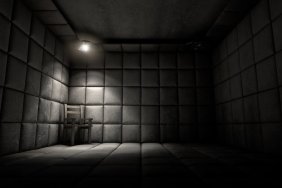Artwork: Painting of Wolves Sitting in a Tree (1964) by Sergei Pankejeff. Oil on canvas. It depicts the dream about wolves that the artist first described to Freud in 1914. Freud Museum, London.
Perhaps there is nothing more terrifying than madness for it goes beyond that which the mortal realm recognizes as one of their own. Since the inception of psychology in the late nineteenth century efforts have been made to treat mental illness as a medical condition though, for the most part, it’s been touch and go. But prior to the advent of psychology, madness was something far more fearsome in that the Western world had lacked knowledge, wisdom, and compassion for the sick. Their treatments were often cruel and unusual, begging the question: which one of these people are truly out of their mind?
Also: Send In the Quacks: “Psychobook” Reveals the Secret World of Psychology Tests
This Way Madness Lies: The Asylum and Beyond by Mike Jay (Thames & Hudson) is a powerful and provocative exploration of mental illness and its treatments at the place popularly known as Bedlam, the Bethlem Royal Hospital in London and beyond. Featuring more than 600 rarely seen photographs and illustrations drawn from the archives of mental institutions in the United States and Europe, the book charts the evolution of the asylum over the course of the eighteenth, nineteenth, and twentieth centuries, the book brings us into the present day world, where the asylum has been replaced by psychopharmacology and therapy.

The Confessional Press and Voice of Wilsey Oswald (c. 1910) by John Gilmour. Gilmour’s art is not therapy but protest against the oppressive asylum regime. Dumfries and Galloway Archives and Local Studies (DGH1/7/3/2/1)
Taken as a whole, it’s nothing short of triggering, like an AK 47 to the head, firing off picture after picture, story after story, treatment after treatment at countless patients whose only crime was to be unfit for the dog-eat-dog into which they were born. The dubious overlay of scenic vistas and stately rooms is all the more unnerving for the actions that took place inside these well-heeled walls. The drawings and photographs of patients make for disturbing contrast with the tools used by doctors upon their flesh. From straightjackets and manacles to chairs that strapped them in at the neck, and hands, you might think you are looking at a book of torture techniques. It’s hardly any wonder the profession pats itself on the back for “improvements” in recent decades.
Claims of humanitarianism occur as pathological propaganda from a malevolent establishment. It’s easy to imagine that doctors failed to take the Hippocratic Oath, for the sheer scale of ignorance is matched only by the spectacle of violence. In many ways, the sick occur as test subjects only fit to be of use for experiment, as though their condition gave doctors the authority to do as they wished.

From a photographic project by Jane Fradgley titled “Held.” These images depict two types of restraining garments worn by patients in London County Asylums. Fradgley said of the clothing: “I was fascinated by the aesthetic considerations possibly intending to protect and care for the wearer whilst maintaining their dignity.” © Jane Fradgley
This Way Madness Lies exposes the underlying quandary with which so many in the profession struggle. As Jay writes in the introduction, “The fundamental questions of madness predate both modern medicine and the law. Is it at root an illness of the body, or a disturbance of the mind? Or, to use the language of the deer past, a sickness of the soul?”
The presumption that the body and mind are mutually exclusive terrains does not take into account the way the endocrine and nervous systems operate on a constant biofeedback loop. To draw attention to the “root” recalls the debate over the chicken and the egg. It is possible to see the systems themselves as the root, and look at the mechanisms that create maladaptive responses instead?
Is madness a sickness of the soul? Before you can engage in this discussion you need to have a framework for understanding the soul. Without this, all discussion is for naught. The soul does not care for the qualifications and rationalizations of the conscious mind. It continuously objects to their oppressive means and ideologies. To speak of the soul would require one to refrain using left-brain tactics to engage. Undoubtedly, this is asking far too much of most, so let’s turn to a question that we face today.

Javier Téllez’s film Caligari and The Sleepwalker (2008) was produced in collaboration with patients from Vivantes psychiatric clinic in Berlin. Responding to the film classic The Cabinet of Dr Caligari (1920) directed by Robert Wiene and set in the Einstein Tower, this film points to an epoch of art and film history in which mental illness as constructed as a pathology. Javier Téllez, Caligari and the Sleepwalker, 2008. Super 16mm film transferred to high-definition video, black and white, 5.1digital dolby surround, Duration 27’07”, original version in German with English subtitles. Courtesy Galerie Peter Kilchmann. © Javier Téllez
Jay asks, “Should sufferers be encouraged to focus inwards and explore the roots of their distress, or outwards to distract them from it and allow them to forge a new life? Should they be secluded from society, which so often seems to be the cause of the illness, or is the solution to be found in integrating them more fully into it?”
The first question, being a false dichotomy, is a logical fallacy. To suggest we partake in a discussion of “either/or” rather than “and” is the old divide-and-conquer technique that must end. The sick should be encouraged to navigate their internal and external worlds, for success is not possible within an irrational paradigm.
This brings us to the second question: Should we seclude the ill? Only if they desire to be shut away—but in light of this book, it would be wise to consider these institutions themselves may not be a healthy place. Perhaps a better question is: Can we trust doctors to do no harm?

This sketch (2014) by Michael Duckett shows ideas for visually appealing patient-centered spaces for mental health services. Courtesy the vacuum cleaner, in collaboration with Hannah Hull. Drawing by Michael Duckett.
Miss Rosen is a New York-based writer, curator, and brand strategist. There is nothing she adores so much as photography and books. A small part of her wishes she had a proper library, like in the game of Clue. Then she could blaze and write soliloquies to her in and out of print loves.





